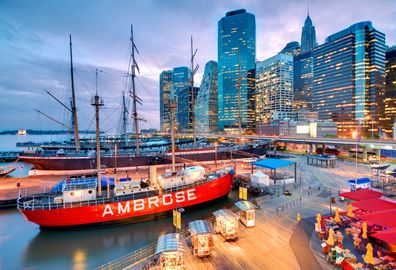

The South Street Seaport is a designated historic district. Although the early 19th century buildings have been restored and many new structures have gone up in the course of the years, the port has preserved its original environment, one that reminds us that in the beginning New York City was a maritime civilization. Today the 12-square-block, 3.5-acre area consists of an archeology museum, exhibition space, a maritime library, a series of historic ships, a shopping mall and the remnants of the famous Fulton Fish Market, which was recently transferred to the Bronx.
The museum complexes at the seaport were established in 1967 by Peter and Norma Stanford. Among the old ships docked at the port, two are visitable: the four-masted Peking, which was built in 1911, and the Ambrose lightship, built in 1908. They constitute the center of attraction for tourists, conveying the spirit of seafaring and maritime trade.
On the opposite side of South Street, if you go west on Fulton Street, on your left you will find the Schermerhorn Row Block. This is a complex of six houses built in 1811 by entrepreneur Peter Schermerhorn when the seaport, thanks to its proximity to Wall Street, was becoming the most dynamic, and profitable, spot in New York. Today these buildings are the oldest in the area. From the middle of the 19th century to the end of the 20th houses number 2 and 4 belonged to Sweet's Seafood House, the oldest seafood restaurant in the city. In 1974 the Schermerhorn buildings were bought by the municipal administration and in the 2000s were turned into galleries and additional museum space.
The former Fulton Fish Market, which had been founded in 1822, stood across from the Schermerhorn Row Block in the buildings that today house several, exceptional, seafood restaurants. The market was one of New York's oldest open-air fish markets and the largest, in size and turnover, wholesale fish market on America's east coast. It supplied seafood caught in the Atlantic Ocean to all the restaurants and retailers of New York City, the southern part of New York State and the northern part of the State of New Jersey. Unfortunately, the market had been associated with Mafia activity and in 2005 the authorities decided to relocate it to the Bronx, where it has gained a better reputation but lost its original flavor.
South Street Seaport suffered severe damage during Hurricane Sandy in 2012. Tides of up to two meters flooded the area ruining many businesses, some of which closed permanently afterwards.